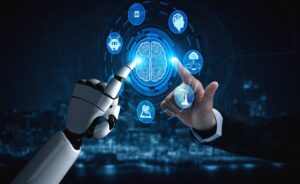The pace at which technology is evolving today is nothing short of astonishing. One of the biggest drivers behind this rapid transformation is Machine Learning (ML) — a branch of Artificial Intelligence that’s changing the way IT departments operate, innovate, and deliver value. No longer just a buzzword, Machine Learning is becoming the backbone of automation and the enabler of truly “smart” systems across industries.
But what does this really mean for the future of IT? Let’s dive in.

From Reactive to Proactive: The New Face of IT
Traditionally, IT teams have worked in a reactive mode — fixing problems when they arise, upgrading systems manually, and responding to user requests. Machine Learning flips this model on its head.
Thanks to predictive algorithms and intelligent automation, IT can now become proactive. Systems can detect anomalies before they cause disruptions. Servers can self-optimize based on usage patterns. Security frameworks can predict potential threats before they manifest.
Imagine a future where network outages are resolved before users even notice them, or where your helpdesk resolves basic queries without human intervention. That’s the world ML is building.
Smarter Systems, Smarter Decisions
Data is often called the new oil — but raw data on its own doesn’t hold much value. Machine Learning refines this “oil” into actionable insights. In IT environments, this means:
Capacity Planning: ML models can forecast future hardware or cloud resource needs based on historical usage patterns.
Security Intelligence: Machine learning algorithms can recognize suspicious activity far better than static rule-based systems.
Performance Monitoring: Instead of setting arbitrary thresholds, ML can dynamically adjust based on real-world operating conditions.
In short, machine learning allows IT systems not just to function — but to learn, adapt, and optimize in real-time.
Automation: Beyond Simple Scripts
When we hear “automation,” many think of basic scripts or repetitive task handling. Machine Learning takes automation several steps further by introducing cognitive automation.
Instead of just doing what they’re told, systems can now:
Analyze scenarios
Predict the best course of action
Execute tasks intelligently
Continuously learn from outcomes
For example, a machine-learning-powered ITSM (IT Service Management) platform can prioritize incident tickets based on urgency, past resolutions, user profiles, and even sentiment analysis from support emails — all without manual intervention.
This level of automation frees up IT teams to focus on higher-value strategic projects instead of getting bogged down by routine maintenance.
Machine Learning in Cybersecurity: A Game Changer
In today’s digital-first world, cybersecurity threats are more sophisticated than ever. Traditional security tools, built on static signatures and pre-defined rules, are often a step behind.
Machine Learning introduces a dynamic layer of defense. It can:
Recognize behavioral patterns that indicate potential breaches
Detect zero-day vulnerabilities
Identify insider threats based on deviations from normal user activity
More importantly, ML-based security tools can adapt as new threats emerge, making organizations more resilient against evolving cyber-attacks.
Challenges to Keep in Mind
Of course, integrating Machine Learning into IT operations isn’t without its challenges.
Data Quality: Machine learning is only as good as the data it’s trained on. Poor-quality data leads to inaccurate predictions and decisions.
Bias and Fairness: If training data is biased, outcomes will be too. IT teams must be vigilant in ensuring ML systems operate fairly.
Skills Gap: Managing ML models requires a different skill set than traditional IT operations. Upskilling existing teams or hiring new talent becomes crucial.
Despite these challenges, the long-term gains are far greater than the short-term hurdles.



Looking Ahead: The Human + Machine Era
There’s a misconception that automation and ML will eliminate the need for human roles in IT. In reality, the future is less about replacing humans and more about augmenting their capabilities.
Machine Learning will handle tasks that are too complex, repetitive, or time-consuming for humans. Meanwhile, IT professionals will focus more on strategy, creativity, innovation, and human-centric problem-solving.
The result? Smarter IT departments that act faster, predict better, and deliver more impactful outcomes for businesses.
Machine Learning is not the future of IT — it’s the present, and it’s moving quickly. Organizations that embrace ML-driven automation and smart systems today will be better positioned to thrive in an increasingly digital, interconnected world.
Whether it’s smarter security, predictive maintenance, or intelligent support, Machine Learning is helping IT shift from a cost center to a true driver of business innovation.
The question isn’t if Machine Learning will reshape IT — it’s how quickly you’re ready to be part of the change.



